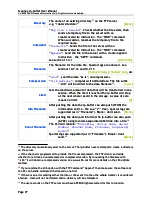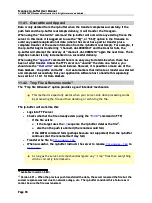
Scannex ip.buffer User Manual
© UK 2007-2021 Scannex Electronics Ltd. All rights reserved worldwide.
11.8. Legacy Emulation (TCP Server)
The legacy emulation option provides the ip.buffer with the ability to behave like legacy
command-line driven buffers.
This option is not visible unless a suitable Emulation Lua script has already
been loaded into the buffer, and the Lua core has been rebooted.
TCP Port
The TCP/IP port to listen on. This port must be a unique number
within the ip.buffer (i.e. you cannot have two channels
listening on the same port number).
Most legacy devices will use port
23
.
[6001]
Interface
“
LAN only
” – allows incoming connections only from Ethernet.
“
Modem only (PPP)
” – allows incoming connections only from
PPP. Ethernet will not connect. Modem dial-ins must use
PPP only.
“
LAN, Modem (PPP & Legacy)
” – Allows Ethernet, dial-in PPP
connection, and legacy-style “dumb” modem dial-in
connections.
[LAN, Modem (PPP & Legacy)]
Allow
You can enter a single name or IP address to restrict access to the
TCP server on the LAN
. Any non-matching clients will
have their connection closed before any data is sent.
(
Hint:
leave this blank until you have the system working, and
then
secure it with a value)
If you want to restrict connections to just “dumb” legacy modem
dial-in, then set this to “127.0.0.1”
[blank]
TLS/SSL
“
No encryption
” – a plain TCP/IP session. Most legacy devices
will not use TLS/SSL for their socket connections.
“
Implicit (by port)
” – starts with an SSL/TLS connection. A
client that connects with plain TCP/IP will time out and
be disconnected
[No encryption]
Client Type
“
Auto
” – if the client software negotiates Telnet options then we
send back further Telnet options.
“
Telnet
” – The ip.buffer sends Telnet options when the client
connects. This is necessary when a Linux telnet command
is used to connect to a non-standard port.
“
Raw TCP/IP
” – No Telnet options. Every byte is transferred
without modification between source and pass-through.
[Telnet]
25
When dialling in with a modem the “Allow” address is ignored.
26
The “dumb” legacy modem dial-in mode will only work if “No encryption” is chosen.
Page 102
Scannex ip.buffer User Manual
© UK 2007-2021 Scannex Electronics Ltd. All rights reserved worldwide.
11.8. Legacy Emulation (TCP Server)
The legacy emulation option provides the ip.buffer with the ability to behave like legacy
command-line driven buffers.
This option is not visible unless a suitable Emulation Lua script has already
been loaded into the buffer, and the Lua core has been rebooted.
TCP Port
The TCP/IP port to listen on. This port must be a unique number
within the ip.buffer (i.e. you cannot have two channels
listening on the same port number).
Most legacy devices will use port
23
.
[6001]
Interface
“
LAN only
” – allows incoming connections only from Ethernet.
“
Modem only (PPP)
” – allows incoming connections only from
PPP. Ethernet will not connect. Modem dial-ins must use
PPP only.
“
LAN, Modem (PPP & Legacy)
” – Allows Ethernet, dial-in PPP
connection, and legacy-style “dumb” modem dial-in
connections.
[LAN, Modem (PPP & Legacy)]
Allow
You can enter a single name or IP address to restrict access to the
TCP server on the LAN
. Any non-matching clients will
have their connection closed before any data is sent.
(
Hint:
leave this blank until you have the system working, and
then
secure it with a value)
If you want to restrict connections to just “dumb” legacy modem
dial-in, then set this to “127.0.0.1”
[blank]
TLS/SSL
“
No encryption
” – a plain TCP/IP session. Most legacy devices
will not use TLS/SSL for their socket connections.
“
Implicit (by port)
” – starts with an SSL/TLS connection. A
client that connects with plain TCP/IP will time out and
be disconnected
[No encryption]
Client Type
“
Auto
” – if the client software negotiates Telnet options then we
send back further Telnet options.
“
Telnet
” – The ip.buffer sends Telnet options when the client
connects. This is necessary when a Linux telnet command
is used to connect to a non-standard port.
“
Raw TCP/IP
” – No Telnet options. Every byte is transferred
without modification between source and pass-through.
[Telnet]
25
When dialling in with a modem the “Allow” address is ignored.
26
The “dumb” legacy modem dial-in mode will only work if “No encryption” is chosen.
Page 102
















































